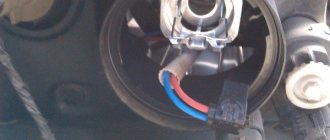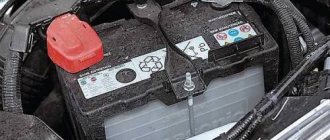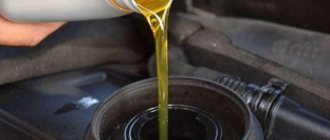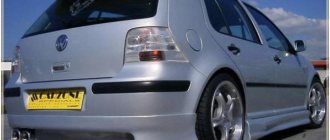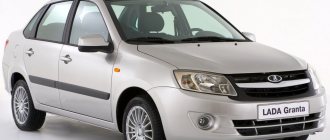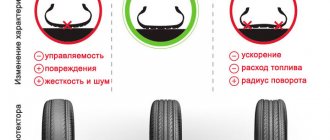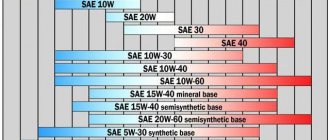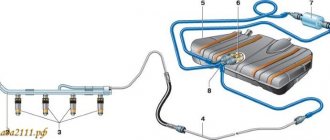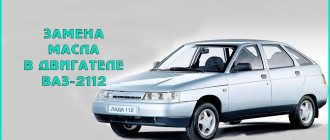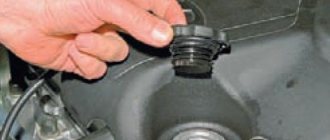What color should headlights be according to traffic regulations?
So, above we have already indicated that there are only 3 options:
- White color,
- yellow,
- orange.
This is prescribed by paragraph 3.6 of the Basic Provisions of the Traffic Regulations, which indicates malfunctions and conditions under which it is prohibited to drive a car:
The vehicle is equipped with: front lighting devices with lights of any color other than white, yellow or orange, and retroreflective devices of any color except white...
Please note that this quote refers to all external lights at the front of the vehicle, not just the headlights. This also includes fog lights, turn signals and additional lighting devices.
All of these primary colors can technically have shades. For example, xenon that is too cold can emit blue or purple. How strongly these shades will influence the possibility of a fine, alas, will be decided by the traffic police officer on the road according to his inner conviction and then by his boss and/or the court if you appeal the decision.
You can also, for example, replace the lamps in the headlights with a cooler or, conversely, warmer color. However, the light source itself should not change. If, for example, you had halogen lamps, then you cannot install LED or xenon lamps, and vice versa.
Contradiction with GOST
But not everything here is so simple! The fact is that the color of the headlights is also regulated by GOST R51709-2001, which in its table 6A (section 4.3 of the standard) indicates a narrower range for each lighting device:
- low beam headlights must be white only,
- for distance, only white is also allowed,
- for fog lights - white or yellow,
- turn signal (front and side) – yellow,
- front marker - white,
- DRL (daytime running lights) – white.
As you can see, there is no talk of any orange at all, and only white color is provided for headlights - also no yellow.
Table of permitted colors of lighting devices
| Front light fixture | According to traffic rules | According to GOST |
| Low beam headlight | White, yellow, orange | White |
| High beam headlight | White, yellow, orange | White |
| DRL | White, yellow, orange | White |
| parking lights | White, yellow, orange | White |
| Turn signal | White, yellow, orange | Yellow |
| Fog lights | White, yellow, orange | White or yellow |
But here everything is actually simpler. The driver must first of all follow the traffic rules. In addition, when imposing a fine, the norm of Part 1 of Article 12.5 of the Code of Administrative Offenses of the Russian Federation is indicated, which prescribes punishment specifically for violation of the Basic Provisions of the Rules, and not GOST.
But the traffic rules still refer to this State Standard, however, only in one requirement for the driver - a ban on operating the car if the headlight adjustment does not comply with the above GOST (clause 3.2 of the Basic Provisions).
Thus, despite the fact that GOST prescribes only white headlights, there is no fine for violating the standard. There are penalties for traffic violations, and in them you can use white, yellow or orange on the front.
When to adjust headlights
Every driver should know when to adjust their headlights. Therefore, if you are not one of them, then let us briefly remind you about this. This procedure is performed in one of the following cases:
Dimming dim lights with horizontally shifted brightness distribution, static low beam, low speed rotator. Light mode for driving on the highway, in the city, in bad climatic conditions, in combination with a navigation system. The projector can be halogen, bi-xenon or xenon. Each headlight is equipped with two-stage electric motors that provide 6° vertical movement and 17° horizontal movement.
- When replacing lamps in a headlight. This applies to devices with both single and separate optics.
- When replacing one or both headlights. This may be caused by its failure, an accident, or the owner’s desire to install a more powerful or technologically advanced lighting device.
- In case you feel that you have become uncomfortable driving with the existing light and need to make adjustments.
- In the case when, when driving in the dark, drivers of oncoming cars flash their high beams at you, thereby signaling that you are blinding them.
- When installing fog lights. As a rule, only the PTF is adjusted.
- After performing work related to changing the stiffness of the suspension.
- When replacing wheels or tires with similar products with different diameters.
- In preparation for undergoing routine maintenance.
- Before traveling long distances.
Monitor the light emitted by your vehicle's headlights and adjust it if necessary. Remember that an incorrectly set light causes discomfort and a threat not only to you, but also to drivers of oncoming cars.
The yellow-elongated beam shape of the reversing headlight makes it possible to quickly identify obstacles in narrow turns. The test requires drivers to recognize unlit red balls located at different distances along both sides of the road. Each driver had a small switch on his left hand that he had to press with his thumb when he recognized the ball.
Future lighting technologies will include various electronic components in the vehicle. The purpose of this article is to familiarize participants in the investment process for the construction of photovoltaic installations with regard to the requirements that must be fulfilled by substructures in the field of corrosion resistance. These issues are very often underestimated during installation projects or the implementation itself.
What light is prohibited?
Based on the permitted colors listed, others are similarly prohibited. But they are prohibited in different ways - to be more precise, the punishment for the color red, for example, is much more severe than for green or another.
Thus, as of 2020, you cannot drive if the color of the front lights is:
- red,
- blue,
- violet,
- green,
- as well as other shades of these colors and others, except yellow, orange and white.
When should you turn on your headlights?
Since the fall of 2010, all vehicles driving on the road during daylight hours must identify themselves using low-beam headlights or daytime running lights (clause 19.5 of the traffic rules). Also, in accordance with paragraph 19.4, it is allowed to use fog lights instead of low beam headlights. Now that more than seven years have passed since the innovation, most motorists have adapted to this requirement. What is it connected with? Of course, with road safety.
It is logical that weather conditions during the day are not always pleasing to drivers - snow, rain, and fog are possible, which often lead to difficulties in detecting other cars on the roadway. In winter, when there is snow, you may simply not notice, for example, a white car on the road, but in spring, against the backdrop of the melting roadside, gray cars are hard to distinguish. In such situations, turning on the headlights will help avoid an accident. That is why traffic regulations oblige drivers to always turn on low beam headlights or daytime running lights.
Important: in modern cars, daytime running lights automatically turn on after the driver turns the key in the ignition. That is, once you start the engine, you don’t have to worry about lights if you are going to travel during the day. Moreover, the running lights turn off automatically if the low beam headlights are turned on. If the car is not equipped with an automatic system for turning on and off the running lights, then, as a rule, drivers prefer to purchase a special module - if installed correctly, its operation will not contradict current laws.
Thus, the question of when to turn on the headlights can be answered unequivocally - depending on the situation, any of the lighting devices should always be on when the vehicle is moving.
See also: Tinting headlights - is it possible to tint rear and front headlights? Fine
What is the fine?
For all violations of the Basic Provisions of the Traffic Rules, with the exception of exceptions when a special norm of stricter liability is applied, the Administrative Code provides for one general punishment - a fine of 500 rubles or a warning under Part 1 of Article 12.5.
That is, for the color of your headlights other than white, red or orange, you will most likely be given a fine (a warning is issued very rarely). But only if we are not talking about the color red. For this reason, a special norm is applied.
Part 3 of the same article already provides for deprivation of rights for a period of six months to a year for red lights in the front of the car. Also, confiscation of lighting devices (lamps) will be applied.
Above we wrote about responsibility for driving a car with violations of the color of lamps or headlights in general. But besides this, punishment is also provided for the installation of such lighting devices - Part 1 of Article 12.4 of the Code of Administrative Offenses provides for another fine of 3,000 rubles for this. And it applies regardless of the nature of the driving violation. That is, two punishments can be imposed: the first - for management, the second - for the fact of installation itself.
But the installation still needs to be proven, because the presumption of innocence and the constitutional possibility not to testify against oneself do not oblige the driver to admit that he himself installed the red lights, even if he is the owner of the car. Therefore, punishments under this standard are rarely imposed in practice in 2020.
Please note that instead of a fine of 500 rubles, you may be deprived of your license. This has been practiced for a long time - the courts have argued that if the work schedule is violated, then Part 3 of Article 12.5 applies. But the Supreme Court put an end to this dispute, pointing out the illegality of this. However, even in 2020, there are cases of deprivation of rights for inappropriate color of lights.
Why do you need to turn on low beam headlights during the day?
Some drivers believe that using low beams during the day is not that important. A similar habit is also started by some instructors at driving schools who do not monitor driving or the car, but simply receive money.
Unfortunately, many people do not understand how important it is to turn on the low beams. In some cases, it can help avoid an accident. Let's figure out what the law says about this and how things stand in practice.
Law. Russian legislation says in black and white that a driver cannot drive a car without low beam headlights on at any time of the day. This requirement must be fulfilled not only in large cities or on highways, but also in sparsely populated areas.
Every year the average speed of new cars begins to increase, so overtaking requires a distance of about 500 meters. At such a great distance it is very difficult to see oncoming cars; the glare from the sun also spoils the view. If the car has low beams turned off, it will be difficult to see it in the rearview mirror. Hence the rule - you cannot operate a car without the low beams on. At the same time, the use of side lights in these conditions can be considered useless - they are significantly inferior in brightness. However, some modern cars are equipped with daytime running lights, which have the same brightness as the low beam lights. Article 12.20 of the Code of Administrative Offenses of the Russian Federation states that if only side lights without headlights are turned on on a car, the driver will be issued a fine of 500 rubles.
Why drivers don't want to use low beams during the day . Any law has followers and violators. Today on the road you can meet a lot of drivers who fundamentally do not use front light sources in the daytime. When they are stopped by traffic police officers, they begin to prove that they are right and give a number of arguments.
For example, many people believe that halogen lamps quickly lose their lifespan when used in this way. However, practice shows that this depends on the position of the car on the road and the voltage level. On the market today you can find decent examples that are in no way affected by machine shaking or power surges. Other drivers believe that when the lights are on, the generator does not work at full capacity, as it recharges the battery. This strange belief has existed since the last century. In fact, the generator operates negatively only in one case - at idle speed. Another important argument is fuel economy. However, numerous experiments show that turning on the lights does not increase fuel consumption to cosmic limits.
Research . Some driving school instructors have conducted an experiment that shows how low beams affect other road users. The Sobol minibus took part in the experiment. The car was parked on the highway at a distance of 300 meters - it was visible. Then the distance was increased to 1 km, and here such a large car practically merged with the road. When he turned on the low beam, the situation changed dramatically.
Bottom line . Numerous experiments show that you need to use low beam headlights even during daylight hours - this will help avoid an accident. An unlit car will not be visible in the oncoming lane even at a distance of 1000 meters.
- Why does the Chinese manufacturer GAC have no chance in Russia?
See all photo news >>
Is it possible to tint headlights?
No. And here, tracking the legislative sequence of such a ban is also quite simple. To do this, we return again to the Basic Provisions of the Traffic Regulations - now clause 7.18, which prohibits driving a car if changes have been made to its design without the permission of the traffic police.
Why is tinting the headlights a design change?! At least, this is what the Technical Regulations indicate. In one of the previous articles, we cited its clause 3.6, which prescribes that the installation of optical parts not provided for by the design on lighting devices, including film, is not allowed - even transparent ones.
Thus, applying black or any other color tint to headlights in any form is prohibited.
Can the reflector be painted black?
Also no. And also because of clause 3.6 of the regulations - it prohibits not only applying tint to the headlight, but also painting parts and installing optical elements in its design that are not provided by the manufacturer.
What is the punishment?
Exactly the same as for the prohibited color of headlights - part 1 of article 12.5 of the Code of Administrative Offenses as a universal norm for any violation of the Basic Provisions of Traffic Regulations. These provisions, in turn, refer to changes in design, and the rules of the latter are precisely regulated by the Technical Regulations.
Cancellation of registration
A fine is not the worst thing that awaits you for violating the ban on tinting headlights. In practice in 2020, deregistration of a vehicle also applies. This is not exactly a formal punishment, but traffic police officers use it precisely for these purposes.
- Article 18 of the Federal Law on Vehicle Registration indicates that a car can be deregistered on the grounds listed in Article 20 of the same regulatory act.
- Clause 4 of Part 1 of this article, in turn, prescribes that machines whose design has been modified are not subject to registration.
- Paragraph 55 of Government Decree No. 1764 directly states that, on the basis of Article 18 of the law, registration is temporarily suspended until the causes are eliminated - headlight tinting.
And something like this happens:
- a traffic police inspector stops you and discovers that the headlights are tinted,
- issues you a fine under Part 1 of Article 12.5 of the Code of Administrative Offenses of 500 rubles,
- you are leaving on your own business,
- After about a week or a month, you receive a letter indicating illegal changes made to the design and an offer to show the car in good condition with the tint removed from the headlights,
- If you do not respond to the letter, you will soon receive a second letter about cancellation of your account.
You cannot drive such a car - otherwise you will face confiscation of license plates and registration certificates, and the car itself will be sent to an impound lot.
Adjusting lensed headlights
Before adjusting lensed headlights, you need to know that there are two types of them - adjustable and non-adjustable. The latter are quite cheap, and we do not recommend using such lighting devices. One example of such a headlight is produced under the Depo brand. Some headlights are equipped with automatic control. However, it often fails, so this is also not the best option.
To adjust lensed headlights, there are also special regulators, as on conventional lighting fixtures. In this case, it is impossible to give unambiguous recommendations, since in different cars and even in different headlights, adjustment occurs using different means. As a rule, adjusting bolts or handles are used for this. But after reading the general instructions for adjusting headlights, you will be able to cope with the task.
